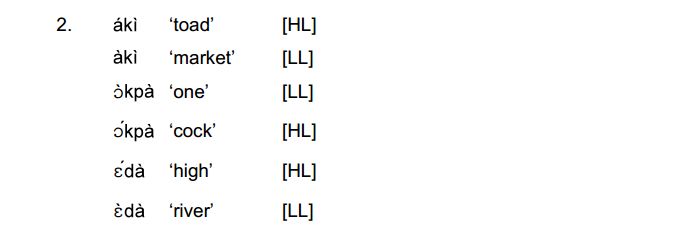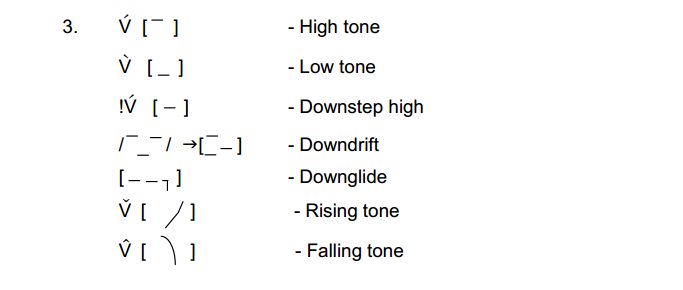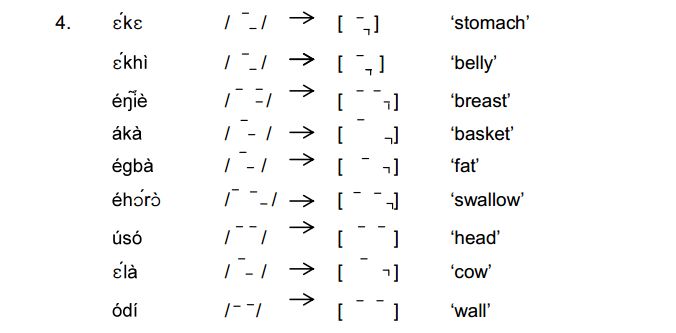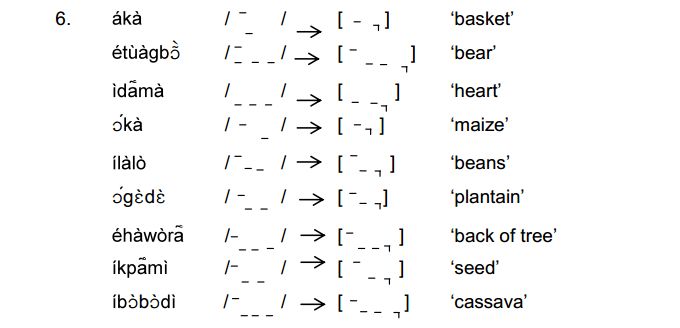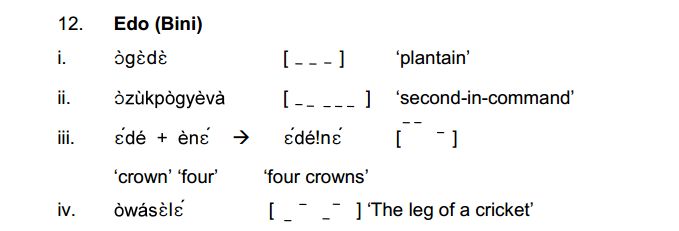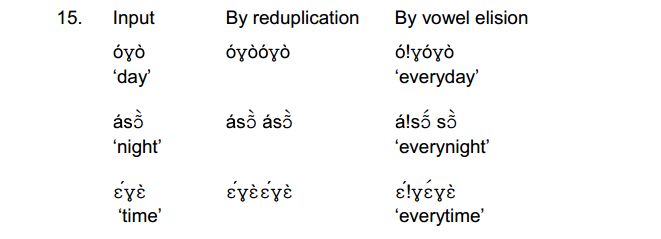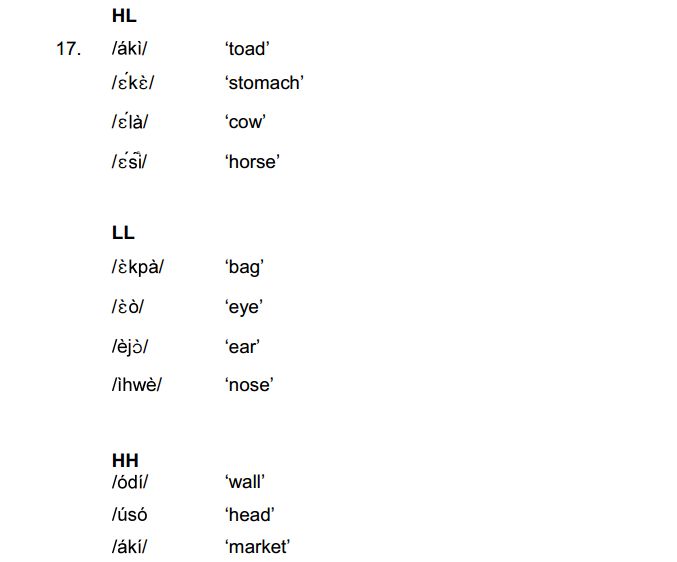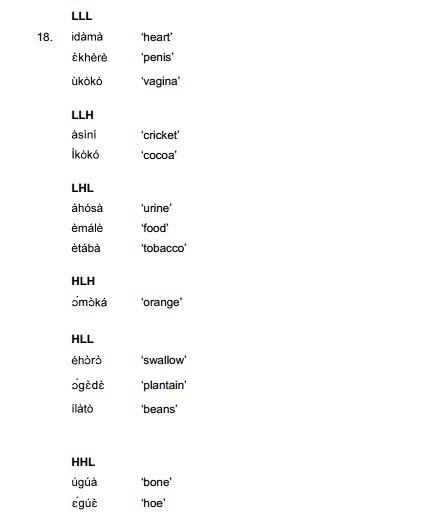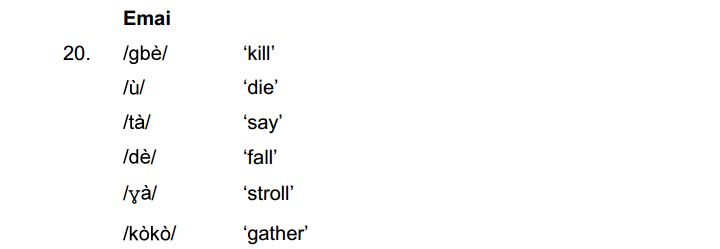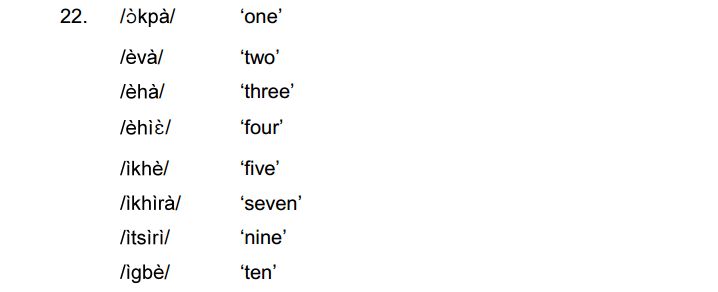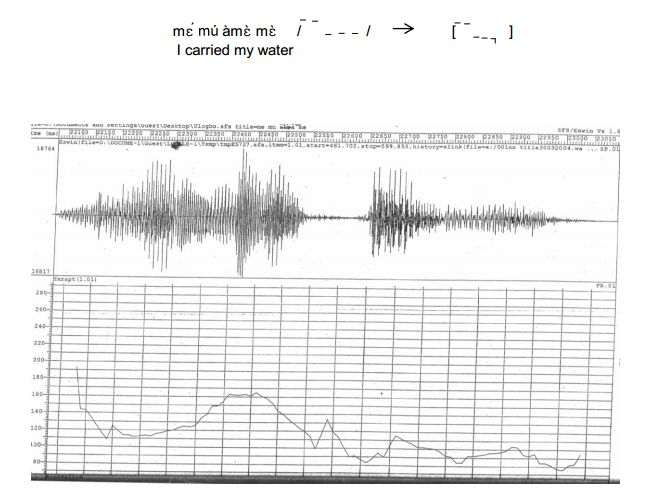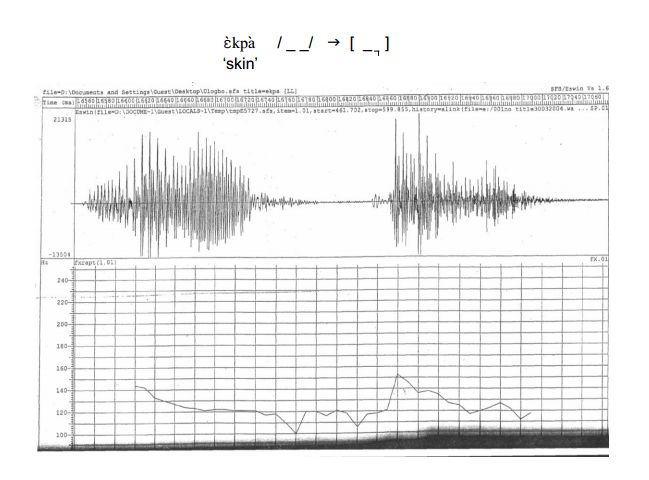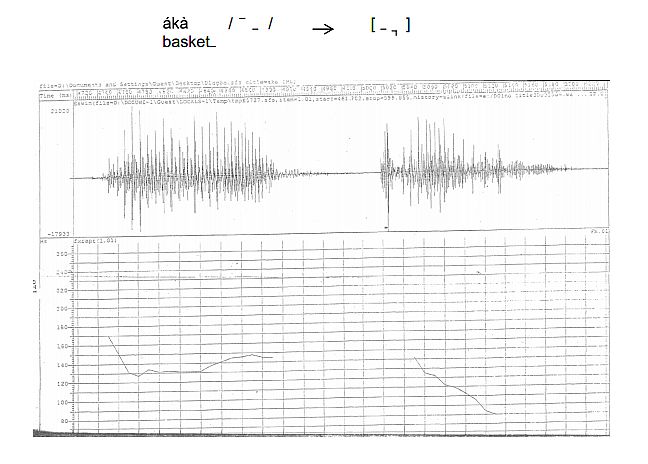Open Science Repository Language and Linguistics
doi: 10.7392/Research.70081942
The Tone System of Ikhin¹
Department of Linguistics, African and Asian Studies, University of Lagos
Abstract
In Ikhin, a North Central Edoid language in the South-South zone of Nigeria, I establish that there are two tones and a downstep. The two tones, high (H) and low (L), are distinctive while the phenomenon ‘downstep’ is not phonemic. In this paper, my findings from an auditory investigation will be supported with some instrumental evidence. The analysis of Ikhin tone system as containing two tones and a downstep means that it is a terraced level tone system. (See examples below). Well known languages with the same type of tone system include Edo (Bini), Emai, both also North Central Edoid, Igbo (Igboid) and Akan (Akanoid). It, however, differs from Edo (Bini) in that downdrift (automatic downstep) affects only low tones while Edo (Bini) has downdrift that affects low (L) and high (H) and has a phenomenon of a disappearing low tone.
Keywords: tone system, Ikhin, Nigeria, language and linguistics.
Citation: Oladimeji, O. (2013). The Tone System of Ikhin. Open Science Repository Language and Linguistics, Online(open-access), e70081942. doi:10.7392/Research.70081942
Received: February 13, 2013
Published: March 15, 2013
Copyright: © 2013 Oladimeji, O. Creative Commons Attribution 3.0 Unported License.
Contact: [email protected]
Introduction
Ikhin is an Edoid language. It belongs to the North Central branch of the Edoid group. Edoid languages are part of what used to be known as Eastern Kwa. Along with the rest of Eastern Kwa, they are now classified as Benue-Congo (BC) where they are recognised as forming a putative West Benue-Congo (WBC). The Edoid group falls into four co-ordinate branches: Delta Edoid (DE); Southwestern Edoid (SWE); North Central Edoid (NCE); and Northwestern Edoid (NWE. Geographically, the Edoid languages spread from the eastern Niger Delta in the Rivers and Bayelsa States through Delta State and Edo State into parts of Ondo and Kogi States. Ikhin is spoken at Ikhin in Owan East Local Government Area of Edo State.
The speakers number approximately thirty thousand and live in the North Western part of Owan East Local Government area in Edo State, adjoining the boundary with Akoko, Idoani and Ifon in Ondo State. Data were obtained from seven purposely selected native speakers in Ikhin town and one from Ibadan, using the 1000 wordlist of the Summer Institute of Linguistics (SIL) and the University of Ibadan wordlist of 400 basic items. Additional data were based on the quantity of tape recorded text materials (traditional stories, conversations and descriptions). In a few cases, examples were taken from isolated unelicited utterances (not tape recorded). The data were analysed using the Speech Filing System of the Computerised Speech Laboratory.
1. Tone typology
Two yardsticks have been used in separating tone languages into two types. The first yardstick is based on the phonetic characteristics of tone and the second is based on the functions of tone in different languages. Pike’s classification of tone languages is based on the phonetic nature of tone. He notes that there are two types of tone languages. The first type consists of languages with mostly level tones and the second types are languages with mostly gliding or contour tones. The distinction between contour and registered tone languages is not absolute. Most systems display some of the qualities of each of the two types.
Languages with level tones are called Register Tone Languages while languages with gliding or contour tones are referred to as Contour Tone Languages. The level toneme is one in which within the limit of perception, the level of the syllable does not rise or fall during its production. In other word, the tone or pitch level is varied. A gliding or contour tone on the other hand, is one during the production of the syllable in which it occurs there is a perceptible rise or fall or some combination of rise and fall. Examples of Register tone languages include Yoruba and Nupe while languages with contour tones are mostly Asian languages e.g. Chinese, Cantonese, Mandarin, Vietnamese, etc.
Furthermore, Welmers goes ahead to sub-classify Register tone languages into discrete level and terraced level tone systems. In a discrete level tone system, each toneme is restricted to a relatively narrowed range of absolute pitch. High, Low, Mid, could maintain their absolute pitch level throughout the phrase. In a three tone system of this type, the last high tone will be as high as the first high tone in the phrase. A good illustration can be found in Yoruba e.g.
In spite of the fact that the low tone spreads from its low position to the following high to give a rising tone on [mǐ] the distance between high and low remains constant throughout the phrase. By contrast, in a terraced level system, the high tone goes down when downdrift occurs with the same number of steps that the low goes down throughout the phrase, thereby maintaining their relative distance from each other.
In a terraced level tone system however, like tones are realised on successively lower levels. This means a high tone may not be realised on the same pitch level all the time. Sometimes, a high tone may fall to the level of a mid after a low tone. In this case, a high tone is said to be down stepped.
2. The typology of the tone system of Ikhin²
Ikhin is a terraced level tone system with two basic tones, high and low. Perceptual analysis suggests that there are two tones; High and Low but sometimes there seems to be some kind of low tone raising in citation form. However, in a construction where an apparent mid relates to other tones they are clearly seen as low. The following are the minimal pairs of words differentiated only by tonal contrast.
Examples:
3. Systematic phonetic tones
Ikhin displays high, low, downstep and downdrift characteristics at the systematic phonetic level. These tones are respectively represented by the following symbols:
4.1 The high tone (H)
Phonetically, the high tone is realised as a high in word initial position or after another high tone:
A high tone is lowered after a low tone, a term that includes declination final lowering, downstep and downdrift. Examples of high tones lowered by the preceding low tones are:
4.2 The low tone (L)
The low tone is phonetically realised as a low tone in word initial position or as the non-final tone in a tone sequence. The low tone ends with a downglide [3] in final position. This final position may be at the end of a word or at the end of a tone phrase.
Apart from downgliding of a low tone in a final position, another phonetic realisation of low tone is the pitch lowering from one low tone to an immediately following low tone. Thus a sequence of low tones without an intervening high tone also drifts downward as exemplified below (see figure 1):
The example above, shows that in a sequence of two low tones preceded by a high tone, the second low tone is lower that the first low because of the influence of the preceding high.
In addition, given a contiguous sequence of two low tones which is immediately preceded by a contrastive high tone, each low is realized on different pitch level. This analysis is ably supported by the attached instrumental evidence on:
4.3 Rising and falling tones
When syllable structure processes (e.g. vowel elision and glide formation) desyllabify the first of two adjacent vowels bearing non-identical tones, contour tones may be formed (Egbokhare, 1990). A contour tone is one in which at least one unit toneme must be described in terms of two distinct components: the direction of pitch change, and also the position of the entire glide within the pitch range of the environment (Welmers, 1973).
Examples:
4.4 Downstep and downdrift
It is no longer new in African Linguistics that, in many languages, downdrift occurs in tone sequences involving alternating high (H) and low (L) tones. This was initially assumed to be a predictable matter of phonetic realization. In such languages, any H preceded by L is realised at a lower pitch than an earlier H – and was commonly referred to as DOWNDRIFT. Downdrift, in this sense, was distinguished from Downstep, in which one H tone is realized at a lower pitch than a preceding H tone without any apparent conditioning factor e.g. Efik,
More recently, however, downdrift and downstep in these restricted senses have generally been seen as manifestations of essentially the same phenomenon. This is reflected in e.g. Stewart’s terms (1983) ‘automatic downstep’ (for surface HLH sequences) and ‘non-automatic downstep’ (where no conditioning factor is present in the surface tonal string). A link between ‘automatic’ and ‘non-automatic’ downstep has generally been recognised since non-automatic downstep can often be traced diachronically or derivationally to automatic downstep, i.e. the effect of low tone that has been deleted.
If a language has two level tones and one downstep or downstepped high tone, two syllable items (i.e. disyllabic items) would show five possible sequences. Example:
In the above language, there are three contrasts after a non-low and two contrasts after a low. Thus in a language with downstep, there is no overt low tone at the surface to indicate the source of key lowering. In the above Efik examples therefore, the downstepped high contrasts with both low and high. Ikhin, as a terraced level tone system, has two tones and a downstep. These two tones are distinctive while the phenomenon of downstep is not phonemic.
In current mainstream analysis, a two tones plus downstep system is regarded basically as a two tone system because the feature called ‘downdrift’ is simply the effect of low tones on the following high tones or in some cases high tones on the following low tones as well. Edo (Bini) and Hausa provide classical well defined effect of two tones system with downdrift. Edo has downdrift that affects low and high and has a phenomenon of a disappearing low tone. By contrast, Hausa has no downstep phenomenon in the sense that lows are always there affecting lows as well as highs.
Examples:
In Edoid languages, the low tone which has lowered a high tone is lost in the surface structure. The loss of the conditioning low tone gives rise to many surface representations in which a high tone is immediately followed by a lowered high tone. Below are examples from languages with tone basic tones like Ikhin.
4.5 Downstep⁴ in morphemes and sentences
Downstepped high tone is created in Ikhin morphemes when a low toned vowel preceding a high toned vowel is deleted following complete reduplication.
In Ikhin, downstep also occurs in sentences and is as a result of vowel elision. A high tone may be downstepepd when a low tone preceding the high tone across a morpheme boundary is desyllabified:
The low tone on each of the verbs above has lowered the following high tone in the underlying structure. This same low tone is lost in the surface structure. Various scholars have postulated floating low tone as the main cause of DS. Stewart (1965) holds that DS originates from a floating low tone preceding a higher or identical tone.
To postulate a floating low tone for downstepped high tone in Ikhin is not out of place. When languages undergo processes of vowel deletion, there are occasions when the vowel or the tone bearing segment is deleted without a deletion of the tone. The tone of such a deleted segment is then set floating and the presence is felt by the type of influence it exerts on surrounding tones. There are three stages involved in the above phonological representations, the first of which is vowel elision. The vowel is deleted without a deletion of its tone, thus setting the tone afloat. At this stage, the tone could not be assigned to any vowel. The second stage is DS insertion. These two stages lend credence to our postulation of a floating low tone before its final deletion at the third stage.
5. Lexical tone patterns
5.1 Nouns
Three tonal combinations are possible in disyllabic nouns in Ikhin. These are shown below:
Besides, there are six tonal patterns in trisyllabic nouns: LLL, LLH, LHL, HLH, HLL, HHL.
5.2 Verbs
It has been reported that in most Edoid languages, monosyllabic and disyllabic verbs in citation forms have low tones.
In Ikhin, as in Emai and Urhobo above, monosyllabic and disyllabic verbs have low tones; however, tonal behaviour on verbs in construction is contextual.
5.3 Numerals
The basic numerals i.e. one to ten, have LL(L) tonal patterns. The only exception is /éhà/ ‘six’ which has LH patterns.
5.4 Demonstratives
Demonstratives in Ikhin have low tones but may manifest different tonal patterns in different constructions.
5.5 Personal pronouns
Personal pronouns on the other hand have high tones in citation forms.
6. Instrumental analysis of the high and low tones in Ikhin
This section presents the results of the phonetic study of the tone system of Ikhin using both perceptual and instrumental analyses.
At a point during perception, one is confused as to whether or not certain tones are low. This triggers an instrumental analysis of the tones. Due to the high level of variability in speech, each of the relevant speech sounds (tones) is represented statistically by the mean and variance around and by which they are respectively distributed. In this instrumental analysis, the difference in frequency between the high and the low tones seems to be smaller than the difference between the high and the low of a three tone language like Yoruba – examples:
In construction, when a high tone precedes a low tone, the difference between the high and the low seems to be higher, thus making the low to be perceived almost like a Yoruba mid. In figure 2, /kpà/ ‘skin’ the tone of the first syllable was realised as 115 Hz; while that of the second syllable was realised as 123 Hz, showing a difference of 7.85 Hz. However, in construction, the first syllable was realised as 125.8 Hz while the tone on the second syllable was realised as 107.3 Hz.
Frequency discrimination dictates that at low frequencies, tones, 8 or 9 Hz apart, can be distinguished; however, at high frequencies, tones must differ by hundreds of hertz.. Critical bands are approximately 100 Hz wide from 20 to 400 Hz, a region within which Fo values normally fall. If we can realise what we perceived as low at a higher frequency than what was sometimes perceived as a mid, it can then be concluded that they are both lows as they are both realised within the same range of 115 Hz to 126 Hz, a mere difference of 11 Hz.
A cursory look at the acoustic analysis for /ákà/ ‘basket’ and /ὲkpà/ ‘skin’ in figures 3 and 2 respectively reveals that the perceived mid tones in citation form for /εkpa/ ‘skin’ was realised as 145 Hz while the low tone in /ákà/, shown in figure 3, was equally realised as 145 Hz. The same analysis goes for /ìbàtà/ ‘shoe’ and /ùlògbò/ ‘door’.
All these examples are a clear evidence of the fact that Ikhin has two basic tones, High and Low. The language exploits these two basic tones to make lexical and syntactic contrasts as shown in the earlier examples.
Conclusion
Following the instrumental phonetic facts given so far, there is no doubt that Ikhin is a terraced level tone system: it has two tones; it has downdrift that affects successive lows where a low tone is realised at a lower level than the immediately preceding low; and it has downstepped high (!H).
Figures 27 and 28 demonstrate clearly the result of the study that Ikhin has two basic tones, high (H) and low (L) while examples 7 and 8 as shown in figures 26 and 28 exemplify the lowering of the pitch level of successive lows. In a tone phrase, the downstepped high (!H) sets a new level so that no high tone may go higher than, or even as high as, its own preceding realization before the point of downstep.
Notes
[1] This paper is essentially drawn from some portions of the chapter 6 of my doctoral thesis. I have however made some changes. I acknowledge with thanks the assistance and contribution of Engineer (Dr) Adegbola who allowed me to use his computerized speech laboratory.
[2] An earlier paper which treats this topic was on the Tone System of Ghotuo (A three tone language) by Elugbe (1986) I have benefited immensely from various works by Elugbe.
[3] Downglide refers to the lowering of a low tone in the word final position.
[4] !H: This refers to downsteppted high tone.
References
1. Adeniyi, H. (2007). A Morphology of Edo. Ph.D Thesis, University of Ibadan, Ibadan.
2. Amayo, A. (1976). A Generative
Phonology of Edo (Bini). Ph.D Thesis, Department of Linguistics and
African Languages, University of Ibadan.
3. Armstrong, R.
(1968). Yala (Ikom): A Terraced Level Language with Three Tones.
Journal of West African Languages.
5(1): 49 -58.
4. Aziza, R. (1997). Urhobo Tone
System. Unpublished Ph.D. Thesis, University of Ibadan.
5. Bakare, C. (1975). Discrimination
and Identification of Yoruba Tones: Perception Experiments and
acoustic Analysis. Languages in Nigeria (eds.) by Kolawole Owolabi.
6. Bennett, P. and
Sterk, J. (1977). South Central Niger-Congo Studies in African
Linguistics
8: 247 – 730.
7. Blench, R. (1989).
New Benue – Congo. A Definition and Proposed Internal
Classification. Arbeits
Papiere.
17: 115 – 147.
8. Blench, R. (1989).
Nupoid in Bendol Samuel (ed.) The
Niger-Congo Languages.
New York: University of America, p. 305 – 322.
9. Clement, G. (1979).
The Description of terraced Level Tone Languages. Language
55.
10. Egbokhare, F.
(1990). A Phonology of Emai. Unpublished Ph.D Thesis,
University of Ibadan.
11. Elugbe, B. (1986).
The Tone System of Ghotuo. Cambridge papers in Phonetics
and Experimental Linguistics.
4: 1 – 21.
12. Elugbe, B. (1989).
Edoid. In J.T. Bendor-Samuel (ed.)
The Niger-Congo Languages,
291 – 304. New York: University Press of America.
13. Elugbe, B. (2009). Comparative Akedoid
and West-Benue Congo. A Talk presented at the Max Planck Institute
for Evolutionary Anthropology, Leipzig, Germany, on November 23,
2009.
14. Elimelech, B.
(1976a). A
Tonal Grammar of Etsako.
Working Papers in Phonetics. University of California, Los Angeles.
15. Goldsmith, J.
(1990).
Autosegmental and Metrical Phonology.
Oxford: Basil Blackwell.
16. Greenberg, J.
(1955).
Studies in African Linguistic Classification.
New Haven: Compass Publishing Company.
17. Greenberg, J. (1963). The
Languages of Africa.
Hague: Mouton and Co.
18. Leben, W. (1973).
The Role of tone in Segmental Phonology. In L. Hyman (ed.) Consonant
Types and Tones
southern California: Occasional papers in Linguistic No. 1: 117 –
149.
19. Marantz, A. (1982). Re Reduplication.
L113, 485 – 545.
20. Oladimeji, O.
(2010). A Phonology of Ikhin, an Edoid Language in South-South,
Nigeria. Unpublished Ph.D Thesis, University of Ibadan.
21. Pike, K. (1948).
Tone
Languages. Ann
arbour: University of Michigan Press.
22. Pulleyblank, D.
(1983).
Tones in lexical Phonology.
Ph.D Thesis, M.I.T. Massachusetts.
23. Pulleyblank, D.
(1986a). Tones
in Lexical Phonology.
Dordrecht: Reidel.
24. Stewart, J, (1981). Key Lowering (Downstep/Dwnglide) in D. Schang. Journal of African languages and linguistics vol. 3. No. 2: 113 – 138.
25. Welmers, W. (1973).
African
Language Structures.
Los Angeles: University of California Press.
26. Westernmann, D. and
Bryan, M. (1952).
Languages of West Africa: Handbook of African Languages, Part II.
London: Oxford University Press.
27. Williamson, K.
(1970s). The Treatment of Downstep. University of Ibadan. Research
Notes 3
(2,3) 22 – 29.
28. Williamson, K. (1970b)
Downstep/Downdrift. In Lan Maddieson (ed.) Tone
in Generative Phonology
23 – 33.
29. Williamson, K. (1971).
Downdrift/Downstep.
Research Notes
(Ib). 3 (2 and 3) 23 – 39. University of Ibadan.
30. Yip, M. (1989).
Contour Tones. Phonology
6(1):
149 – 174.
31. Yip, M. (2002). Tone. United Kingdom: Cambridge University Press.
Cite this paper
APA
Oladimeji, O. (2013). The Tone System of Ikhin. Open Science Repository Language and Linguistics, Online(open-access), e70081942. doi:10.7392/Research.70081942
MLA
Oladimeji, Olaide. “The Tone System of Ikhin.” Open Science Repository Language and Linguistics Online.open-access (2013): e70081942. Web. 15 Mar. 2013.
Chicago
Oladimeji, Olaide. “The Tone System of Ikhin.” Open Science Repository Language and Linguistics Online, no. open-access (March 15, 2013): e70081942. http://www.open-science-repository.com/the-tone-system-of-ikhin.html.
Harvard
Oladimeji, O., 2013. The Tone System of Ikhin. Open Science Repository Language and Linguistics, Online(open-access), p.e70081942. Available at: http://www.open-science-repository.com/the-tone-system-of-ikhin.html.
Science
1. O. Oladimeji, The Tone System of Ikhin, Open Science Repository Language and Linguistics Online, e70081942 (2013).
Nature
1. Oladimeji, O. The Tone System of Ikhin. Open Science Repository Language and Linguistics Online, e70081942 (2013).
doi
Research registered in the DOI resolution system as: 10.7392/Research.70081942.

This work is licensed under a Creative Commons Attribution 3.0 Unported License.

